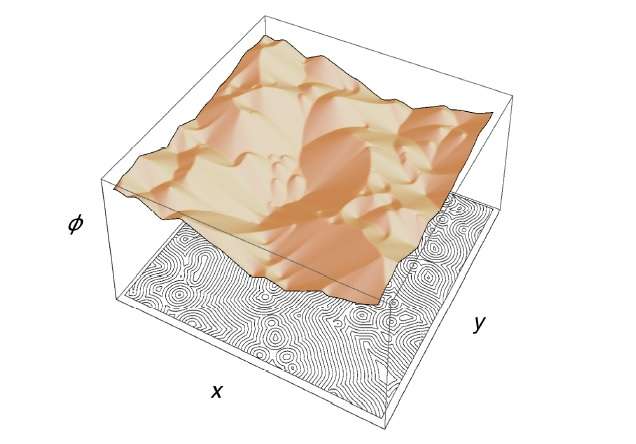April 19, 2016 feature
Two different crystals can be described by the same mathematical rules

(Phys.org)—Scientists have found that an intricately beautiful yet poorly understood type of crystal found in soap bubbles follows the same mathematical rules as a much better understood type of crystal called martensite. Due to its extreme hardness, martensite has been used since the Iron Age to make swords and horseshoes. The soap-bubble crystals, on the other hand, which are called smectic liquid crystals (where "smectic" is derived from the Greek word for "soap"), have turned out to be what the scientists describe as "the world's weirdest martensite."
While all crystals are known for their highly ordered, aesthetically appealing structure, smectic liquid crystals stand out because their microstructure is particularly unusual. Full of beautiful patterns of ellipses and hyperbolas that bend, rotate, and curve around each other, the microstructure of smectic liquid crystals has fascinated researchers since they first turned their microscopes upon them over a century ago. Martensite microstructure, on the other hand, is characterized by a simpler striped pattern.
Discovering the connection between the two seemingly different types of crystals required the meeting of two experts in these areas: Randall Kamien, a physicist at the University of Pennsylvania who studies smectic liquid crystals, and Cornell University physicist James Sethna, who specializes in martensites.
In a new paper published in Physical Review Letters, Kamien, Sethna, and their coauthors have modified the mathematical theory of martensites so that it also explains the unusual features of smectic microstructure. It turns out that the rules that describe how all of the ellipses and hyperbolas fill 3D space in the smectic microstructure are very similar to the rules that describe the relatively simpler patterns in martensitic crystals.
"I'm excited because a weird, anomalous scientific backwater with beautiful phenomena has now been fit into a standard framework," Sethna told Phys.org. "The mathematically beautiful theory of martensites, which until now mostly predicted layered structures, now has an amazingly rich example, smectic liquid crystals."
The resulting new theory of smectic microstructure captures observations made as far back as 1922, when the French mineralogist Georges Friedel discovered that smectic layers bend in a very specific way, into so-called "cyclides of Dupin." These layers of curved surfaces have centers of curvature that all lie along another single curve. As the curved surfaces somewhat resemble flower petals curving around the center of a flower, the cyclides of Dupin give the crystals a "flower texture." All of this highly ordered curvature also enables the complex surfaces to pack together very tightly.

Another characteristic that results in tight packing in the smectic microstructure is called "Apollonian packing." Since there are small gaps between the ellipses, these regions are filled with smaller ellipses, and the gaps between them are likewise filled with even smaller ellipses, all the way down to the molecular scale. Both the Apollonian packing and cyclides of Dupin occur for the same reason: they offer the most energetically favorable arrangement for this crystal.
Besides the connection between the two crystals, there is another mathematical connection in this work, which is that to special relativity. In smectic liquid crystals, the cyclides of Dupin form concentric circles of increasing size that form cones which look like the "light cones" in special relativity. Light cones represent the path of light as it broadens in all directions, like light emerging from a flashlight. Since the crystal and light models are geometrically identical, the same math used in special relativity, such as manipulating the shapes with Lorentz transformations, can be used to describe these crystals.
"The links to Einstein's relativity are both real and theoretically cool," Sethna said.
Although the new theory of smectic liquid crystals and martensites describes many characteristics of both crystals, questions still remain regarding some of the unique geometrical features, and the researchers hope to continue to investigate these tiny structures in future work.
"We're hoping to extend our tools to analyze experimental smectic microstructures," Sethna said. "There are some new imaging methods that should allow the layer orientations to be understood in three dimensions, and we should be able to use our numerical methods to figure out how the cyclides of Dupin (each with an ellipse and a hyperbola) fit together to fill the volume, adapt to changing boundary conditions, and evolve as the smectic flows."
More information: Danilo B. Liarte, et al. "Weirdest Martensite: Smectic Liquid Crystal Microstructure and Weyl-Poincaré Invariance." Physical Review Letters. DOI: 10.1103/PhysRevLett.116.147802
Journal information: Physical Review Letters
© 2016 Phys.org




















